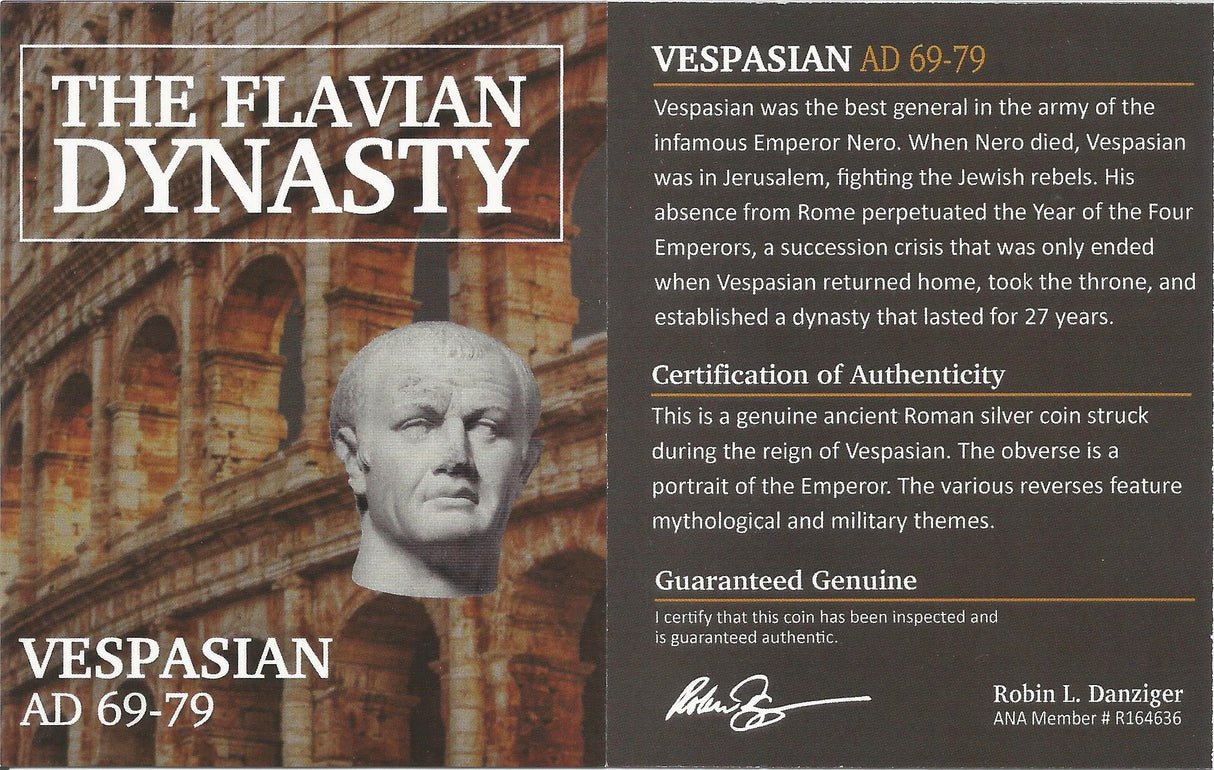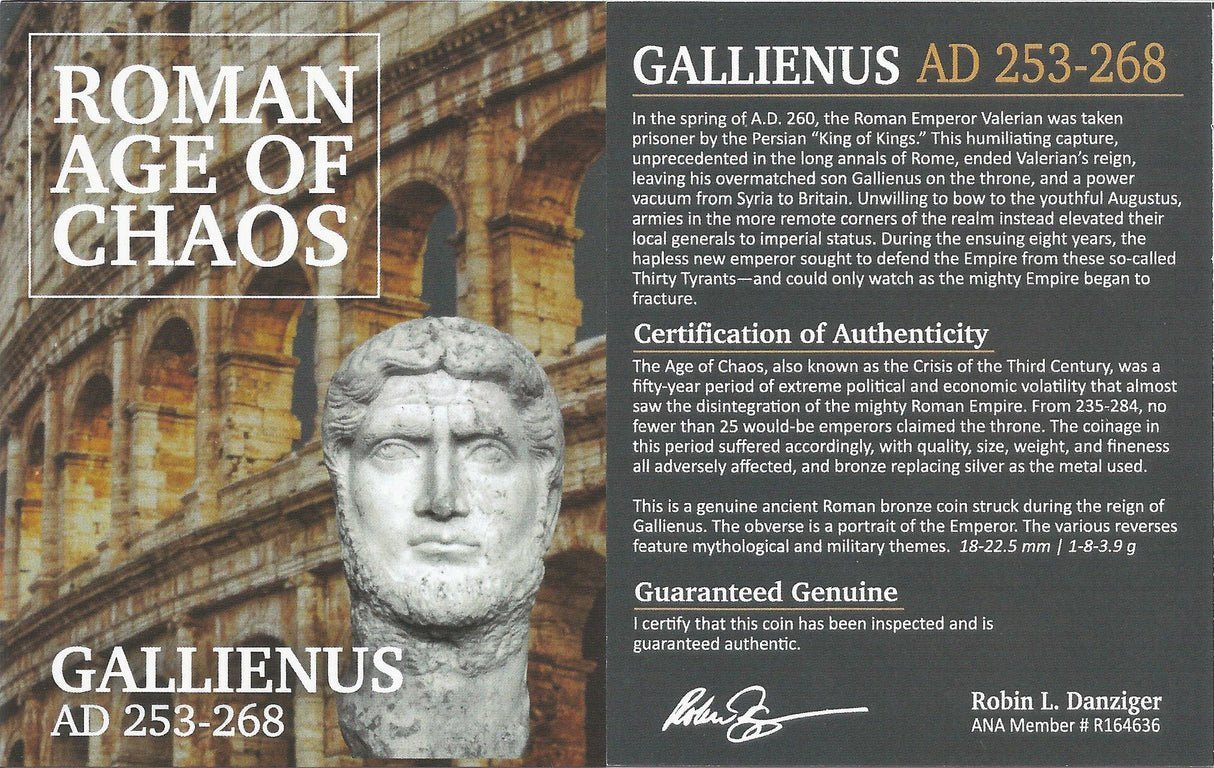 Image 1 of 9
Image 1 of 9

 Image 2 of 9
Image 2 of 9

 Image 3 of 9
Image 3 of 9

 Image 4 of 9
Image 4 of 9

 Image 5 of 9
Image 5 of 9

 Image 6 of 9
Image 6 of 9

 Image 7 of 9
Image 7 of 9

 Image 8 of 9
Image 8 of 9

 Image 9 of 9
Image 9 of 9










Roman Silver Coin of Emperor Vespasian (about 1,950-1,960 years ago)
This silver denarius was issued under Emperor Vespasian, the battle-hardened general who established the Flavian dynasty after emerging victorious from the chaotic Year of Four Emperors. After decades of successful military service, Vespasian brought much-needed stability to Rome following Nero's suicide and the brief civil war that followed, implementing practical reforms and undertaking ambitious building projects that transformed the imperial capital.
Coin Description:
Front side: Portrait of Emperor Vespasian facing right, typically laureate (wearing a laurel wreath), with Latin inscription giving his name and titles
Back side: May feature various Roman deities, personifications of virtues, or symbols of peace and prosperity that Vespasian wished to emphasize after the recent civil wars
Technical Details:
Silver composition
Denomination: Denarius
NGC certified in protective slab
Minted between 69-79 AD
Condition as certified by NGC
Historical Significance: Vespasian's rise to power marked a crucial turning point in Roman history, restoring stability after the turbulent end of the Julio-Claudian dynasty. A career military commander of humble origins, he had distinguished himself in Britain and during the First Jewish-Roman War before seizing power in 69 AD. As emperor, he focused on practical governance—reorganizing finances, strengthening the frontiers, and initiating major building projects including the Colosseum (Flavian Amphitheater). His pragmatic approach extended to his personal life; when criticized for taxing public urinals, he reportedly held up a coin and noted "money doesn't stink," a saying that lives on in his legacy, along with the linguistic vestige of his name for public toilets in several Romance languages (vespasiano in Italian, vespasienne in French).
This silver denarius was issued under Emperor Vespasian, the battle-hardened general who established the Flavian dynasty after emerging victorious from the chaotic Year of Four Emperors. After decades of successful military service, Vespasian brought much-needed stability to Rome following Nero's suicide and the brief civil war that followed, implementing practical reforms and undertaking ambitious building projects that transformed the imperial capital.
Coin Description:
Front side: Portrait of Emperor Vespasian facing right, typically laureate (wearing a laurel wreath), with Latin inscription giving his name and titles
Back side: May feature various Roman deities, personifications of virtues, or symbols of peace and prosperity that Vespasian wished to emphasize after the recent civil wars
Technical Details:
Silver composition
Denomination: Denarius
NGC certified in protective slab
Minted between 69-79 AD
Condition as certified by NGC
Historical Significance: Vespasian's rise to power marked a crucial turning point in Roman history, restoring stability after the turbulent end of the Julio-Claudian dynasty. A career military commander of humble origins, he had distinguished himself in Britain and during the First Jewish-Roman War before seizing power in 69 AD. As emperor, he focused on practical governance—reorganizing finances, strengthening the frontiers, and initiating major building projects including the Colosseum (Flavian Amphitheater). His pragmatic approach extended to his personal life; when criticized for taxing public urinals, he reportedly held up a coin and noted "money doesn't stink," a saying that lives on in his legacy, along with the linguistic vestige of his name for public toilets in several Romance languages (vespasiano in Italian, vespasienne in French).
This silver denarius was issued under Emperor Vespasian, the battle-hardened general who established the Flavian dynasty after emerging victorious from the chaotic Year of Four Emperors. After decades of successful military service, Vespasian brought much-needed stability to Rome following Nero's suicide and the brief civil war that followed, implementing practical reforms and undertaking ambitious building projects that transformed the imperial capital.
Coin Description:
Front side: Portrait of Emperor Vespasian facing right, typically laureate (wearing a laurel wreath), with Latin inscription giving his name and titles
Back side: May feature various Roman deities, personifications of virtues, or symbols of peace and prosperity that Vespasian wished to emphasize after the recent civil wars
Technical Details:
Silver composition
Denomination: Denarius
NGC certified in protective slab
Minted between 69-79 AD
Condition as certified by NGC
Historical Significance: Vespasian's rise to power marked a crucial turning point in Roman history, restoring stability after the turbulent end of the Julio-Claudian dynasty. A career military commander of humble origins, he had distinguished himself in Britain and during the First Jewish-Roman War before seizing power in 69 AD. As emperor, he focused on practical governance—reorganizing finances, strengthening the frontiers, and initiating major building projects including the Colosseum (Flavian Amphitheater). His pragmatic approach extended to his personal life; when criticized for taxing public urinals, he reportedly held up a coin and noted "money doesn't stink," a saying that lives on in his legacy, along with the linguistic vestige of his name for public toilets in several Romance languages (vespasiano in Italian, vespasienne in French).
Vespasian (/vɛsˈpeɪʒ(i)ən, -ziən/; Latin: Vespasianus [wɛspasiˈaːnʊs]; 17 November AD 9 – 23 June 79) was Roman emperor from 69 to 79. The last emperor to reign in the Year of the Four Emperors, he founded the Flavian dynasty, which ruled the Empire for 27 years. His fiscal reforms and consolidation of the empire brought political stability and a vast building program.
Vespasian was the first emperor from an equestrian family who rose only later in his lifetime into the senatorial rank as the first of his family to do so. Vespasian's renown came from his military success;[6] he was legate of Legio II Augusta during the Roman invasion of Britain in 43 and subjugated Judaea during the Jewish rebellion of 66.[7]



























